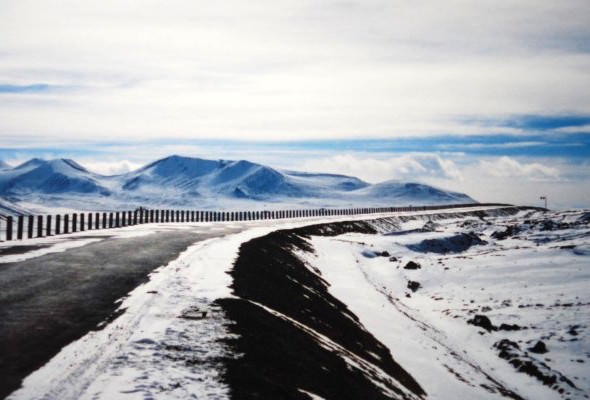Abrupt Climate Change Can Occur Even Before a 2-Degree Rise in Warming
Sudden shifts in settled climates can occur long before global warming reaches the internationally agreed safety level, European scientists say.
By Tim Radford, Climate News Network

Extensive melting of the snow on the Tibetan plateau could be a tipping point. (katorisi via Wikimedia Commons)
This Creative Commons-licensed piece first appeared at Climate News Network.
LONDON — Climate change could arrive with startling speed. New research has identified at least 37 “tipping points” that would serve as evidence that climate change has happened — and happened abruptly in one particular region.
And 18 of them could happen even before the world warms by an average of 2°C, the proposed “safe limit” for global warming.
Weather is what happens, climate is what people grow to expect from the weather. So climate change, driven by global warming as a consequence of rising carbon dioxide levels, in response to more than a century of fossil fuel combustion, could be — for many people — gradual, imperceptible and difficult to identify immediately.
But Sybren Drijfhout, of the University of Southampton in the UK and his collaborators in France, the Netherlands and Germany, are not so sure.
They report in the Proceedings of the National Academy of Sciences that they “screened” the massive ensemble of climate models that inform the most recent reports from the Intergovernmental Panel on Climate Change, and found evidence of abrupt regional changes in the ocean, the sea ice, the snow cover, the permafrost and in the terrestrial biosphere that could happen as average global temperatures reached a certain level.
The models did not all simulate the same outcomes, but most of them did predict one or more abrupt regional shifts.
No safe limit
But the future is not an exact science. “Our results show that the different state-of-the-art models agree that abrupt changes are likely, but that predicting when and where they will occur remains very difficult,” said Professor Drijfhout. “Also, our results show that no safe limit exists and that many abrupt shifts already occur for global warming levels much lower than two degrees.”
The idea of a “tipping point” for climate change has been around for decades: the hypothesis is that a climate regime endures — perhaps with an increasing frequency of heat waves or windstorms or floods — as the average temperatures rise. However, at some point, there must be a dramatic shift to a new set of norms.
The researchers explore some of the telltale indicators of such abrupt change. One of these would be the wholesale collapse of the Arctic Ocean winter ice: the Arctic is expected to be largely ice-free most summers in the next few decades. Winter ice would then become increasingly thin. Once sufficiently thin, warming and wave power would do the rest, and tend to leave clear blue water even in the coldest seasons.
Another indicator would involve massive unexpected plankton blooms in the Indian Ocean as a consequence of an upwelling of nutrient-rich waters from the ocean bottom, in response to changes in the Asian monsoon regime.
A third would involve massive snow melt on the Tibetan plateau: in 20 years, the annual average snow cover could fall from 400 kilograms per square metre to a trifling 50kg.
A fourth signal would be massive dieback in the Amazon rainforest over a few decades, mainly because of reduced rainfall.
Early signs
Yet another telltale aspect of climate change has already been addressed by Professor Drijfhout. It would be the sudden, paradoxical dramatic drop in temperatures in the North Atlantic, as a response to global warming and a collapse of the ocean current that carries warm surface water north, while denser, colder and increasingly more saline water in the Arctic sinks to the bottom and flows back southward. This “overturning circulation” has already seemed to weaken as the Arctic has warmed.
In one of the team’s climate model simulations, the Atlantic circulation system keeps ticking over until about 2020. For another 20 years, sea and air temperatures vary wildly and the ocean current weakens much more swiftly. After about 2040, ice starts to form on the North Atlantic. By 2060, the circulation system has collapsed and the sea ice starts to spread.
“Increase of sea ice in the whole Atlantic sector of the Arctic causes a temperature decrease of more than 4 °C in a 20°-wide latitude band (55°N-75°N), stretching from 60°W to 40°E”, the scientists say. South of 40°N and outside the Atlantic, global warming continues. Only a portion of oceans in northern Europe would see dramatic cooling.
But that is a result from only one model of a number which predict varying levels of change for Europe.
The researchers add that the models aren’t perfect: they don’t simulate some things that really could happen, and perhaps show signs of happening now. They conclude:
“An additional concern is that the present generation of climate models still does not account for several mechanisms that could potentially give rise to abrupt change.
“This includes ice sheet collapse, permafrost carbon decomposition, and methane hydrates release.”
Your support matters…Independent journalism is under threat and overshadowed by heavily funded mainstream media.
You can help level the playing field. Become a member.
Your tax-deductible contribution keeps us digging beneath the headlines to give you thought-provoking, investigative reporting and analysis that unearths what's really happening- without compromise.
Give today to support our courageous, independent journalists.









You need to be a supporter to comment.
There are currently no responses to this article.
Be the first to respond.